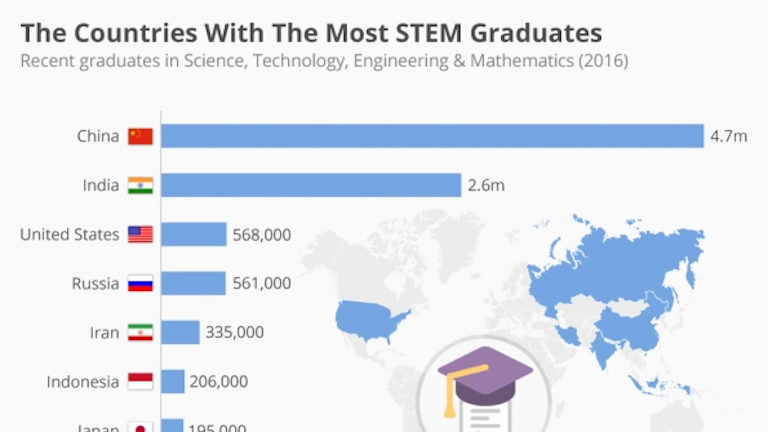| | | Following up on this from 2010 Message 26565875 , the latest known happening is Message 33073857
Something about studying, learning, working, saving, investing ... etc etc, and arms and legs attached to brains
The investment is beginning to pay off, so that Message 26306977

industryweek.com
The Countries With The Most STEM Graduates
China has experienced a revolution in third level education since the turn of the century. By 2016, it was building the equivalent of nearly one university every week and in terms of graduate numbers, it has surpassed both Europe and the United States

Historically the U.S. dominated the world's graduate population but in recent years, that population has shifted amid steady academic progress in Asia. Last year, India was the global leader in university graduates (78.0 million), slightly ahead of China (77.7 million). The U.S. was in third place (67.4 million) and the gap behind the top two is widening. According to some estimates, the number of Chinese graduates aged 25 to 34 will rise 300 percent by 2030 compared to just 30 percent in the U.S. and Europe. STEM (science, technology, engineering and mathematics) has become a pretty big deal in China's flourishing universities. In 2013, 40 percent of Chinese graduates completed a degree in a STEM subject, more than twice the share in American third level institutions. Workers with STEM qualifications have become increasingly important to global prosperity and unsurprisingly, China is leading the way. The World Economic Forum reported that China had 4.7 million new STEM graduates in 2016 while India had 2.6 million. The United States had 568,000 recent STEM graduates in 2016.
As Team America is intending to cull its PhD program of Chinese, more shall rejoin the Team
Probably more efficacious and consequential than culling Team Brazil of Chinese PhD students
axios.com

Chinese students make up 16% of all graduate STEM students in the U.S. and 2% of undergraduate STEM students, per a new report from Georgetown University's Center for Security and Emerging Technology.
The big picture: Concerns about intellectual property theft and foreign influence in U.S. research have led to calls to limit what Chinese students can study in the U.S.
At the same time, others argue U.S. universities benefit financially and, ultimately, the country benefits economically from the contributions of students from China."These conversations have been hampered by a lack of granular data on the number of enrolled Chinese students by field and degree level," CSET's Jacob Feldgoise and Remco Zwetsloot write.What they found: Using four different datasets, the researchers report there are "around 46,000 Chinese undergraduates, an estimated 40,000 master’s students, and an estimated 36,000 Ph.D. students" in STEM fields in the U.S.
The percentage of Chinese students is lower than an earlier government report's estimate that 25% of STEM graduate students in the U.S. were Chinese nationals.Yes, but: The new estimates still don't give a certain picture, says Zwetsloot, "driving home the need for much better U.S. government data collection and dissemination on these questions." |
|







